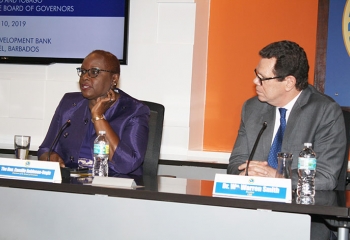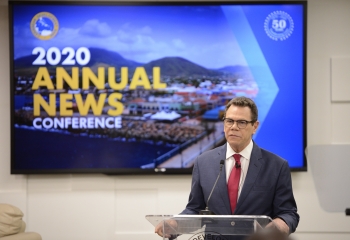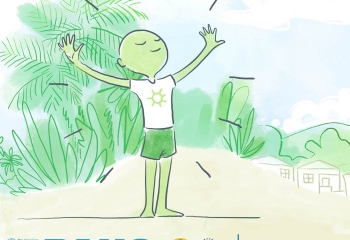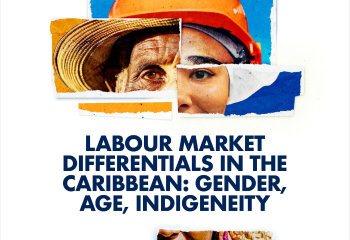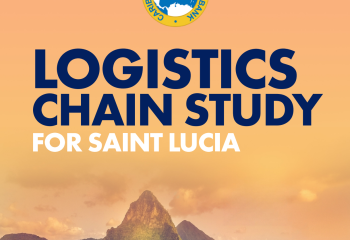Statement- Opening Ceremony of the 51st Annual Meeting of the Board of Governors
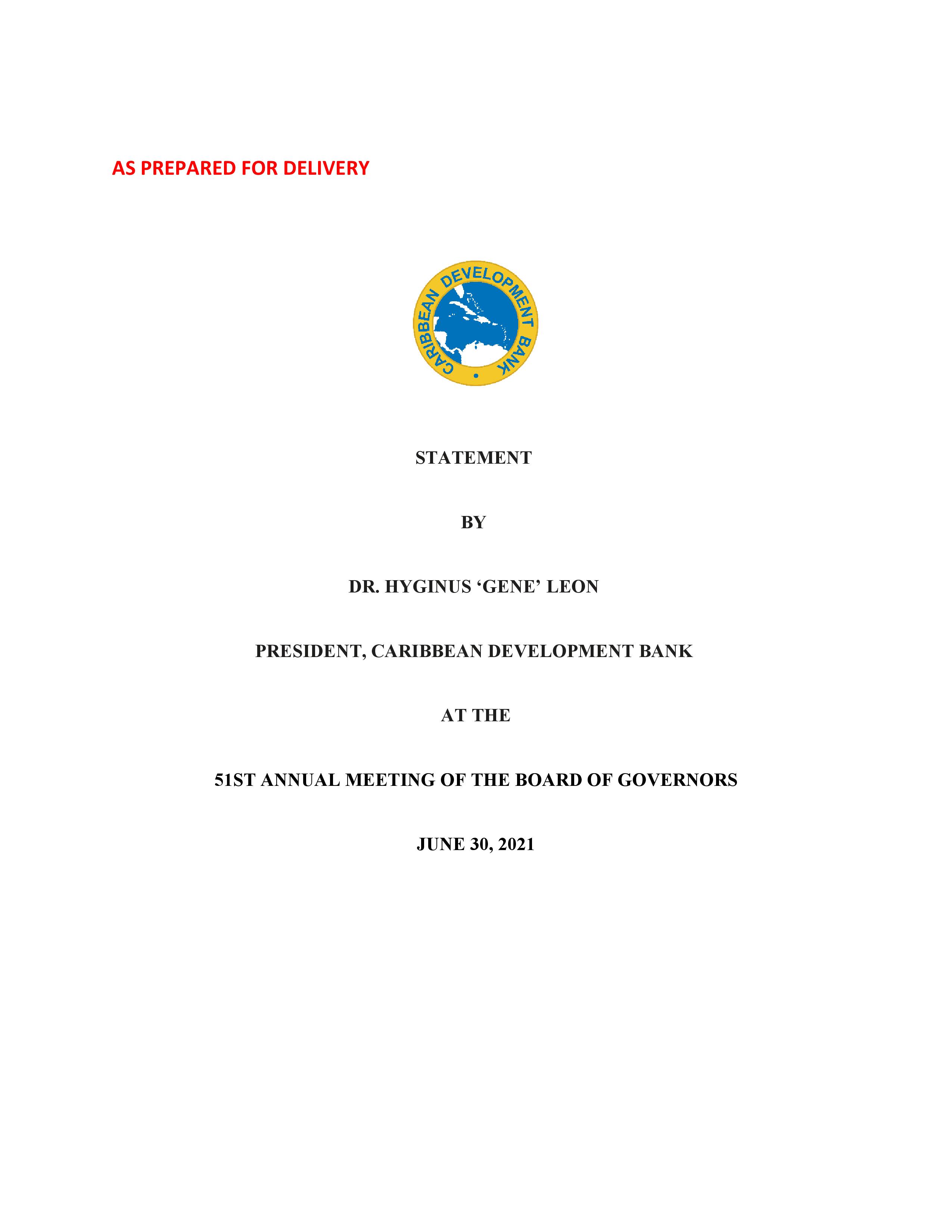
Introduction
It is a distinct pleasure and honour to deliver my first Board of Governors’ statement during what is projected to be a challenging but potentially impactful five-year term as President of the Caribbean Development Bank. The confluence of unfinished structural challenges, evolving climate change, and amplifying impact of the COVID-19 pandemic leaves policy makers with little choice but to confront the creation of our future in a bold and decisive manner. The mandate establishing the Caribbean Development Bank is as important today as it was in 1969, and, if suitably re-imagined, can remain relevant for the next 50 years.
This is the aspiration we need to embrace – helping shine the light on and pave the road to the consensus goal of sustainable and inclusive growth. Leading this distinguished organisation during these unprecedented times presents me with a unique opportunity to tackle the crippling challenges our Region faces. Like my predecessors, who have fought the noble cause, I seek to continue a tradition of service and commitment to the advancement and development of our region and its people.
Through the legacy left behind by the astute leadership of my predecessors -- Sir Arthur Lewis, Dr. William Demas, Sir Neville Nicholls, Dr. Compton Bourne, and Dr. Wm. Warren Smith -- and with your support, I wholeheartedly and confidently take hold of the baton to continue this relay race.
I am aware that I have taken on a monumental task. I can state confidently that I will persevere; and ably supported by the competent cadre of professionals who welcomed me into the Bank almost two months ago, I am determined to make a contribution toward realising the dreams of our people. The institutional machine is well tested and tried, the staff – namely the fuel and lubricants – are rearing to go, and the ignition spark has been lit, starting the engine to a thunderous roar!
Since the first cases of COVID-19 was recorded on March 10, 2020, the pandemic has wreaked havoc on Caribbean economies and societies. As a health crisis, the pandemic has placed a heavy burden on health systems, likely not designed for this kind of impact. From an economic perspective, it led to a collapse of economic activity with unprecedented negative growth rates; set back the steady gains in poverty alleviation and inequality; put in slow-motion the educational advancement of our youth and underlined the pernicious vulnerability of export concentration. Our tourism-concentrated economies have been severely hit, as were counterparts worldwide; and many of our social protection systems hang precariously in the balance.
While the pandemic has spared no one, there is the inescapable and untenable reality that not everyone has felt its socioeconomic consequences in the same way. Reports show that women are faring worse with regard to the economic impacts of COVID-19, as they generally earn less, save less, and tend to occupy more insecure jobs, or are more likely to live in poverty than men[1]. We have seen the prevalence of unpaid care work increase significantly during the pandemic, as schools have closed, and families are spending more time at home. This is having a greater impact on women who typically take on a greater burden of house tasks related to care than men. Deeper economic and social stress, coupled with movement restrictions and social isolation, have also led to an exponential rise in gender-based violence [United Nations (UN), 2020], and quite likely sewn the seeds of deep emotional trauma, the effects of which may still be unfolding.
To be honest, we had our fair share of structural impediments to sustainable growth before COVID 19. So, while this unwelcomed visitor, COVID-19 is also a wakeup call to action, it is the alarm clock heralding the time has come to shake away the feeling of slumber. When combined with the additional and multidimensional vulnerability that characterises the countries of the region, we can only ask, with some trepidation, how will we deliver on the promise of inclusive and sustainable development that is embodied in our commitment to the Sustainable Development Goals (SDGs)?
This morning I propose to:
- take stock of where we are as a region;
- elaborate on the role of innovation in building resilience and advancing the standards of living of our people; and
- outline the role of the Bank in facilitating this development and define how we must transform to adequately fulfil this role.
Evidence-based Decision-making - Measure Better to Target Better
Let us assume that we can take for granted the non-trivial notion of a national, even regional, consensus on the main challenges we need to address urgently. How do we forge agreement on acceptable, clearly articulated, and measurable targets and anchors?
A foundational principle would be to foster evidence-based decision-making, ensuring the analyses are robust and based on data that is accurate and of high quality. As a first pass, it appears that we do not have robust data architectures that would allow for adequate monitoring or provide tools for adaptive change. For example, where are we today with respect to the SDGs? Can we argue confidently about policies needed to achieve specific targets and over what period of time?
Since committing in 2015 to the 2030 Agenda for Sustainable Development, only seven of the Bank’s nineteen BMCs have managed to submit Voluntary National Reviews, outlining and reporting the pace of SDG implementation. Notwithstanding, BMCs in the main have sought to align and anchor their respective national development plans and policies to the SDG framework, with many establishing national bodies to oversee SDG mainstreaming and localisation. Most, however, have singled out the enduring challenges of data paucity and insufficient statistical capacity in BMCs to monitor, report, and formulate evidence-based policies which directly respond to the SDGs. Equally, concerns regarding inadequate funding and the ever-present risk of natural hazards to SDG implementation is a recurring theme throughout the BMCs’ Voluntary National Reviews, thus derailing efforts towards the SDG.
While credible data on the region’s progress is absent, it is equally clear that actions to meet the goals are not advancing at the speed and scale required. Mind you, this concern is not unique to the Caribbean, leading UN Secretary General Antonio Guterres to issue a global plea for us to make this a “Decade of Action”. Our statistics are at best disheartening. Economic growth, which has been receding in the last 50 years, slowed to an average of 0.4% during the ten years to 2019. The impact of COVID, especially in the tourism-dependent economies, amounted to double-digit declines in growth. With poverty rates already high - largely clustered between 20% and 40% - the pandemic has, no doubt, worsened these rates, moving the region further away from this SDG goal.
Access to education took a blow during the pandemic, with the digital divide retarding access and raising concerns about the longer-term implications for human capital accumulation. We can only imagine the cumulative devastation that could ensue from a severe hurricane season! What this amounts to, and as evidenced by less onerous periods of our history, is that our ability to recover to pre-catastrophe levels is weak – it takes many years, is very costly, and we are prone to repeated events. The shocking reality is that after all of the effort and financing we would NOT have grown relative to our pre-catastrophe state!.
As a starting point, we need to measure better to target better. That includes building data architectures and databases to better inform our evidenced-based decision making; involves improving capacity in data analytics, leveraging developments in big data and digital technology; and requires better measurement of the impact of our vulnerabilities and articulating better the nexus among enabling resilience for increasing public value, promoting priority growth-oriented investment, and managing financing needs for debt sustainability.
I propose creating a data hub at CDB. Could we not be the go-to portal on regional data? Could we not design and build a distance-to-SDG tracker that updates not only implementation but associated measures of distances to benchmarks, quantum of financing needs, and estimates of concessionary terms that could facilitate more rapid reductions in these distance metrics? Could we not extend this to a resilience tracker that informs on various dimensions of resilience and therefore our ability to recover or sustain a growth momentum?
Innovate to Build Resilience: Share to Grow
At the core, I believe that sustainable and inclusive growth requires resilience. Because sustainable livelihoods are founded on the principles of stable ecosystems, resilience needs to be interpreted broadly to include resilience in social development (health and education); in institutional capacity; in the environment (markets and nature – disasters/hazards); resilience to external shocks (trade, spillovers); and by extension, resilience in the integration of all of these on macroeconomic outcomes.
The pace and state of development of the Region is rooted in its low resilience, for example to global economic shocks and natural hazard events. The transmission of such shocks is often acute and protracted because of the high level of export concentration that characterises the Region. The main source of this export concentration is a lack of competitiveness that leaves countries specialising in exports that rely largely on natural endowments. By increasing productivity and reducing costs or introducing new products or product varieties, innovation promotes export diversification. This export diversification generates resilience by reducing the susceptibility of national output to the fortunes of a one or two industries.
Resilience, in turn, requires innovation. So, eliminating poverty, advancing standards of living, and delivering equitable prosperity by ensuring that no one is left behind will depend critically on our ability to innovate. Innovation describes the development and application of ideas and technologies that improve goods and services or make their production more efficient. [2] Let me underscore that innovation ultimately depends not only on inventors, but equally on the creativity of the potential users of the new technology to find new ways to put existing concepts and ideas to productive use.
The role of innovation as a driver of economic prosperity is well established. In fact, both neoclassical growth and endogenous growth theories, emphasise technological advancement, of which innovation is a critical part. One of the hallmarks of innovation is its ability to utilise limited resources to expand production possibility frontiers, resulting ultimately in higher levels of outputs – a concept which should be particularly attractive to and be embraced by the Caribbean given the scarce resource endowments that are available.
A healthy innovation ecosystem incorporates many of the aspects of resilience mentioned earlier. For example, the Global Innovation Index includes institutional features such as the regulatory environment; the environment within which human capital is created and research and development is undertaken; information and communications infrastructure; the quality, size, and sophistication of markets; and the level of business sophistication. While we will not dwell on every aspect of resilience and its innovation nexus, the same principles outlined below will apply.
To begin, innovation can be operationalised through the backbone framework or process of KIDS – Knowledge, Innovation Diagnostics, and Strategies. The KIDS process is flexible and outcome-based, is agile, can be applied at firm, sector, or economy-wide levels, can leverage strategic international partnerships, foster development of institutional capacity, and promote backward and forward linkages. As a tool it is bounded only by the imagination of our people and has the potential to create the “industrialisation of knowledge.” KIDS operates in three interacting phases, each of which can be used to create high value-added segments of the supply chain, and hence has the potential to unlock economic diversification.
As an illustration, application of knowledge accumulation, which is the gathering, organising, refining and disseminating of information, can spawn search, scan, classification, and archiving technologies and products.
Second, innovation diagnostics, which fosters discovery by establishing a synthesis of success factors from the accumulated knowledge, can be used through partnerships with tertiary institutions (regional and external) to promote centers of excellence and integrate knowledge tourism.
Third, strategies, which transform the synthesised knowledge to create and market specific viable business propositions, can be implemented at home, regionally, or globally. Noting that, as a people, we do NOT have a comparative disadvantage in generating knowledge, that the process can be applied on a modular basis in practically any field of interest, and because we can, especially with digital technologies, tap into the infinite supply of global knowledge, [reminiscent of Sir Arthur Lewis’ unlimited supplies of labour], we can harness the unbounded imagination of our people.
It is important to note that the absence of comparative disadvantage referred to early has to be maintained. That requires our education systems to promote, even more, learning processes that based on inquiry, discovery, and problem solving. I propose a long-term investment focus on innovation in Education, to build social resilience.
Having recognised the importance of innovation, how do we create an appropriate environment for promoting and sustaining innovation?
Global experience suggests that those countries that create a healthy environment for innovation are more prosperous and more resilient. Such countries include Switzerland, Sweden and Finland. However, small states such as Singapore, which is consistently among the top 10 most innovative states, are also consistent high performers that demonstrate the strong link between innovation, resilient economic growth, and development.
Much like the recently published Cornwall Consensus identified critical roles for G7 governments in fostering a climate of inclusion and innovation, Caribbean governments are called upon to cultivate a regulatory environment that encourages entrepreneurship and innovation. There is need for a financial system with sufficient depth to accommodate appropriate levels of risk taking; education systems that place value on critical innovative thinking and reward students accordingly, and a Caribbean society that embraces a culture of creative disruption.
A critical weakness in the environment for innovation is also the size of individual markets. I believe successive generations of regional leaders have recognised this, and endeavoured to create first the Caribbean Community and Common Market and subsequently the CARICOM Single Market and Economy. Colleagues, if we are to deliver on the post-COVID acceleration that is required to achieve the SDGs, we must spare no effort in completing the full establishment of the CSME. Let me further state, that it is not only about creating a larger market to facilitate scale, it is also about partnering with the private and other non-public sectors to co-create markets and institutions, aimed at achieving a common purpose. It is this investing in and harnessing of regional public goods that will create an enabling ecosystem for innovation.
Role of CDB: Thought leadership and championing of transformation agenda
The mission of the Bank is to achieve social and economic development, and in this regard, the Bank and its BMCs have signed on to the SDGs. Our current task is to systematically take stock of where we are with respect to the SDGs and assess the level of effort that it will take to get us there. This requires a number of things.
First, we must properly map the theory of change between those goals and the activities and outputs that we must undertake.
Second, we must establish the volume of spending that is required on these activities and outputs.
Third, we must map the development financing matrix that will get us to these outputs and activities.
Fourth, we must determine the level of resources that CDB must mobilise as part of this effort.
Finally, we must determine how we go about mobilising these resources.
Innovation will play a critical role. CDB must be a vibrant part of an innovation ecosystem that drives the knowledge products facilitating these efforts. Specifically, knowledge products will be important in areas such as the theory of change underpinning the goals; the role of public sector investment, governance structures and public sector regulatory frameworks; monitoring and implementation systems; and financing modalities and instruments. Therefore, the Bank must be a thought leader on these issues, from a regional context.
The Bank will also have to continue to play a role in mobilising finance to upgrade the infrastructure and institutions that are important in improving competitiveness and productivity, increasing innovation and resilience, driving growth, and the achieving the SDGs. Our preliminary estimates suggest that to reach our goal of halving poverty by 2030 would require more than a doubling of average CDB lending. This underlines the magnitude of the task at hand, the need for multiple sources of funding and financial instruments, as well as a clear identification of the role that CDB is expected to play in marshalling this development finance. Such considerations require further discussion on the fit-for-purpose size of the Bank.
The susceptibility of the Region to natural hazard events and the increasing intensity and frequency of these natural hazard events resulting from climate change also plays a role in defining the optimal size of the Bank. Natural hazard events typically reduce the capital stock while also reducing the stream of output from that capital stock. This means that such natural hazard events increase the capital needs of a country and suggest the interest rate at which this capital is financed should be appropriately lower. This is counter to the standard market dynamics, where increased perception of risk would increase the rates of interest required of countries in the wake of a natural hazard event; and would push those rates to levels that lead to adverse debt dynamics, given lower output trajectories and higher interest rates. This market failure and the expected losses associated with natural hazard events in the region increases the level of financing that the static development deficits that currently exist would suggest.
A clear narrative from operational experience is a large implementation deficit. The Bank will need a strong focus on innovation to build resilience in implementation capacity in BMCs. This will not only accelerate the pace of development; it will also increase the effectiveness of every dollar loaned or granted. So institutional strengthening and adherence to the highest governance standards would be another area of focus.
If the Bank is to function as an effective development partner in the drive towards the SDGs and beyond, then it must remain relevant and fit-for-purpose, and is appropriately sized, skilled and structured. Internal structures will need to be reconfigured to better equip the Bank to meet the needs of its BMCs within the context of their development milieu. The creation of internal ecosystems for generating ideas that lead to efficiencies will be important. Appropriate structures that optimally leverage the experience and expertise of staff to produce knowledge products is an area for improvement.
Conclusion
In conclusion, the road ahead is surely not paved in gold. But our challenges are clear; our resolve is resolute; our collective passion is fired up; and we will aim to be good stewards in serving our members.
Thank you
[1] See UN, 2020; World Bank, 2020 and World Trade Organization, 2020)
